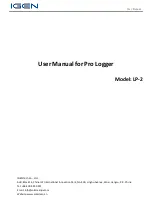
www.tinytag.info
www.tinytag.info
www.tinytag.info
www.tinytag.info
sales@tinytag.info
sales@tinytag.info
sales@tinytag.info
sales@tinytag.info
Tinytag Plus Radio Data Logger with Two Temperature & Relative Humidity Probes
Tinytag Plus Radio Data Logger with Two Temperature & Relative Humidity Probes
Tinytag Plus Radio Data Logger with Two Temperature & Relative Humidity Probes
Tinytag Plus Radio Data Logger with Two Temperature & Relative Humidity Probes
((((----25 to +85°C/0 to 100% RH) x 2
25 to +85°C/0 to 100% RH) x 2
25 to +85°C/0 to 100% RH) x 2
25 to +85°C/0 to 100% RH) x 2
TGRF-4502
Issue 6
Issue 6
Issue 6
Issue 6 (16th June 2017) E&OE
Power Information
Battery Power
Battery Type
2 x Duracell Industrial ID1400
C (LR14) 1.5V (supplied)
The logger will operate with other C cell batteries but performance cannot be
guaranteed.
Battery Life
Typically 12 months
When the logger’s batteries start to run flat, a low battery warning will be
displayed in the Tinytag Explorer Connect software and the LED on the front
of the logger will flash red. The low battery warnings will start to flash when
the logger has approximately two weeks of battery power remaining.
Before replacing batteries the logger must be turned off.
Alkaline batteries should always be replaced in pairs.
Data stored in the radio system will be retained after batteries are replaced.
A lithium battery powered version of the logger is also available, that
provides a wider working temperature range and a longer battery life.
Please contact your supplier for further details.
Mains Power
The logger can also be powered from the mains using a plug-in power supply.
If the power supply is interrupted, the logger’s batteries will power the logger
and continue recording until the supply is restored.
Note: This logger should only be used with an ACS-0044 Tinytag Plus
Radio power supply.
Logger Mounting/Positioning Instructions
The logger can be wall mounted or placed
on its back on a flat surface, such as a
shelf.
The logger's back-plate has mounting
holes, as shown.
The logger can also be positioned on a non-
conductive flat surface, such as a desk or a
shelf, with its antenna positioned vertically,
with no loss of performance.
Physical Specification
Probe Mounting Instructions
A mounting clip is supplied with the logger for fixing the probe to the logger or
a wall.
The clip has a self-adhesive pad for mounting the probe on the side of the
logger or a flat surface, and a 5mm diameter screw hole for fixing it to walls or
shelving etc.
Physical Specification
Suggested positioning for the RH probe if using the supplied clip to
mount it on the logger.


















